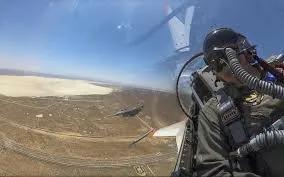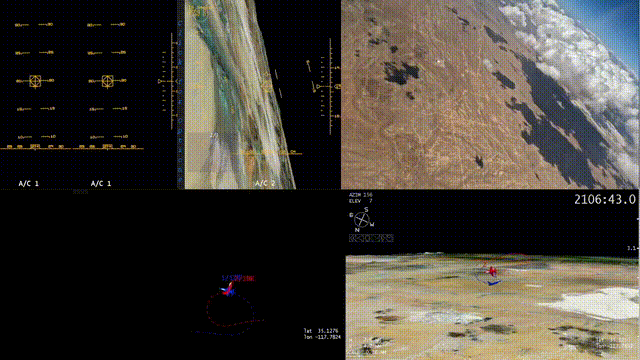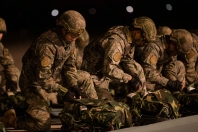Recently, the US Air Force announced an "epoch-making" technological breakthrough - fighter planes controlled by artificial intelligence (AI) seem to have "autonomous air combat" capability! Frank Kendall, the Secretary of the US Air Force, also personally took the fighter controlled by AI pilots and experienced various air combat scenes such as close combat in the air. The Associated Press proudly declared that this is the most important technological breakthrough in the military aviation field since the stealth technology, and other countries in the world "including China" do not have such capabilities.
Is the US Air Force really "far ahead" again?
First, let's see what functions the American AI pilots have achieved. According to the Star Spangled Banner, the X-62A fighter Kendall took was actually a modified two seat F-16D Block30 fighter from the US Air Force Test Pilot School. It is equipped with VISTA ("Variable Stability Flight Simulator") simulation system, so that students of the test pilot school can experience various flight characteristics. The machine was fully upgraded in 2022, and three new highly specialized software suites were introduced. These software suites have powerful computing power and can realize advanced AI applications.

The Associated Press reported on the 4th that this AI controlled fighter took Kendall on a historic flight. During the flight, the plane flew at a speed of more than 550 miles per hour, and Kendall suffered an overload of five times his own gravity. It almost confronted another manned F-16, and the two planes fought, rolled and circled at a distance of 1000 feet from each other. During the whole flight, Kendall and the pilot in charge of safety in the backseat did not touch the control device of the X-62A, demonstrating the aircraft's autonomy.
After an hour long flight, Kendall climbed out of the cockpit with a smile. He said, "For decades, we have been imagining the unlimited potential of autonomous air to air combat, but it has always been out of reach. But now, we have reached a moment of transformation." According to Kendall, he has seen enough in the flight process, and is willing to trust this AI to decide whether to launch weapons in the war.
Reviewing the development history of the US Air Force for AI pilots, it can be found that all these have traces to be found. In 2022, the Defense Advanced Research Projects Agency, together with the Air Force and Lockheed Martin, integrated AI pilot algorithms into the X-62A system, and in December of that year, used these algorithms to conduct the first autonomous flight test of a jet aircraft. The flight system of the X-62A can be configured to imitate any other aircraft type, which enables it to complete various test purposes.

The US Air Force announced that AI pilots successfully controlled the X-62A flight in 12 tests in December 2022. The testing activities involve two AI systems, namely, "Autonomous Air Combat Operations" (AACO) of the Air Force Research Laboratory (AFRL) and "Air Combat Evolution" (ACE) of the National Defense Advanced Research Projects Agency. The AI agent of AACO plan conducts one-on-one over the horizon (BVR) engagement against the simulated opponent, while the AI agent of ACE performs within the horizon maneuver, which is called "dog fight".
At the same time, AI pilots constantly simulate confrontation with human pilots through simulators, and repeatedly strengthen their skills. In April this year, the US Air Force Test Pilot School and the Defense Advanced Research Projects Agency announced that they had completed the first "dog fight" between AI and fighter controlled by human pilots. This successful experience in April promoted Kendall's personal experience. Kendall said that a smaller and cheaper AI controlled unmanned jet is the future development direction. The US Air Force has planned to purchase 1000 AI controlled unmanned wingmen.
According to the Associated Press, military users of the X-62A said that no other country in the world has jet aircraft controlled by AI like this. "Although China also has AI, there is no indication that China has found a way to test outside the simulator.". For AI pilots, just like junior officers learning tactics for the first time, some courses can only be learned in the air.

So the question comes, is the era of AI air combat really coming, which makes the US Air Force so excited? If we study these AI air combat information of the US Air Force in detail, the conclusions may be quite different. Zhang Xuefeng, a Chinese military expert, believes that AI led air combat is gradually approaching reality, but it still needs breakthroughs in at least two aspects to make AI independent for air combat. On the one hand, AI pilots also need to learn and iterate constantly to master tactics more skillfully. In the "alpha dog fight" simulation air battle organized by the US military, AI defeated human pilots five times on the simulator. However, if the air combat is divided into four stages: observation, judgment, decision-making and implementation, it can be found that the "alpha dog fight" at that time was mainly better than the observation and implementation stages. Because it can directly read data from the system and drive the fighter to maneuver, it is faster than human pilots. However, AI has not yet demonstrated such advantages in the critical judgment and decision-making stages.
The other breakthrough is how to "observe". Because air combat within visual range mainly searches, tracks, identifies, and then makes judgments and decisions through the pilot's eyes. There is a popular saying in the field of close combat: "If you lose sight, you lose the fight." That is, if a pilot loses visual tracking of the target aircraft in a fierce and complex air battle, it means that he will lose the fight. But at present, the X-62A is tested by the target machine to transmit its own position in real time through the data link, so that the X-62A can "observe" the position of the opponent - which is essentially like "cheating". Therefore, to independently perform close combat tasks, AI also needs a sensor with or beyond the human eye.
Liu Wei, the director of Beiyou Human Computer Interaction and Cognition Engineering Laboratory and an expert in human-computer hybrid intelligence, believes that in the increasingly complex air battlefield environment, pilots must timely process massive information from meteorological data, navigation data and aircraft sensor data and screen key factors. One of the core advantages of AI pilots is that they can efficiently process these information and make fast and accurate flight decisions. On the other hand, this advantage may also become a fatal loophole for AI pilots, because AI pilots are highly dependent on training and data, and it is difficult to deal with situations that are inconsistent with training data or have not encountered before. When human beings face massive information or even contradictory information, they often make judgments based on experience and intuition. The judgment of AI pilots is strictly based on information data. If the opponent intentionally releases a lot of wrong battlefield information, it will seriously interfere with the decision of AI pilots. He also said that the current development of AI technology can not solve the "fraud" and "calculation" problems in the field of military intelligence, so the human-computer integration of "human+AI" is needed to deal with the increasingly complex future war.
Source: Privy Council No. 10/veteran driver Ma Zhitu
Editor in charge: Liu Debin



















